Soviet lunar scientific station "Barmingrad"
"Barmingrad"
The design team, led by Academician Vladimir Pavlovich Barmin, began developing the lunar station in 1962. Above the project worked Design Bureau of General Engineering, which was located in Moscow on Berezhkovskaya embankment. Space housewarming was planned for the end of the 1980-s. It was planned to use the station for both civil and military purposes. The base could become a unique platform for deploying missiles that would be practically invulnerable from Earth, and special reconnaissance equipment for spying on the United States. The moon also attracted Soviet scientists for its geological features. Already in those years it was known that the natural satellite of the Earth contains large reserves of tritium - the ideal fuel for the thermonuclear power stations of the future. At the same time, the Soviet cosmonaut Alexei Leonov believes that military goals are rather fiction, although the launch positions on the Moon were indeed planned, but for what purposes, military or civil, it did not matter.
In total, several thousand different organizations were involved in the work on the project of the future lunar town. The scope of work was divided into three areas: lunar structures, lunar transport and energy.
The Soviet engineers planned to deploy the base on the moon in the 3 phase:
1. Start to the lunar surface of automatic spacecraft, which would deliver to the Earth samples of lunar soil from the places that were chosen to house the base.
2. Sending to the lunar surface of the first module in the form of a cylinder, a lunar rover and a team of astronauts to conduct on-site primary research.
3. Debugging messages between the Moon and the Earth, delivery of additional equipment to the satellite: new base modules, nuclear power plants, i.e. It was assumed active development of the natural satellite of the Earth.
Soviet astronauts were supposed to work on the moon on a rotational basis - for 6 months for each team of cosmonauts from 12 people. It was planned to populate the lunar town, as noted above, by the end of the 1980s. According to the well-known Soviet cosmonaut Alexei Leonov, who was the first to go to outer space, the readiness of the Barmin project was quite high, even the crews of lunar ships were selected. “Currently it seems to me that in the lunar team there should be from 3-s to 5-ti people in order to provide a more comfortable combination of characters. I am sure that this will be the case on the future Russian base, ”said Alexei Leonov.
The specifics of the first stage of work on the lunar base was that by the time work began, no one had enough experience not only of manned cosmonautics, but even accurate data on the surface structure of the Earth’s satellite. It was clear only that special structures created for research work in the Arctic, studying the depths of the ocean and flying into space are not suitable for use in lunar conditions. To ensure a long stay of people on the Moon, it was not enough to achieve the combination in one design of the strength of deep-sea bathyscaphes, the lightness of Arctic houses and the protection of spacecraft. It was necessary to make the whole structure work in a reliable mode for many years.
A necessary requirement for the creation of stationary lunar structures was the condition for the transformation of the structure. At the initial stage of development, the architects decided to use the usual rectangular shape of the structure. This configuration won over with the convenience of the layout and an acceptable combination of structural elements of a rigid frame with an inner soft shell. At the same time, the power ribbed core was compact during transportation and could easily transform. Filling the cells of the structure with expandable plastics made it possible to obtain reliable and durable lunar structures. However, the appeal to the cubic forms in the lunar architecture turned out to be suboptimal. The main issue of space architecture is the organization of the internal space of cells and the definition of rational size of rooms. The excess volume only worsened the weight characteristics of such premises.
As a result, the architects moved to the spherical and cylindrical shapes of the premises. They planned to fill the interior with inflatable furniture. Considered and the recommendations of psychologists, according to which the living cells were designed for two people. In order to eliminate the effect of a closed space that a person has, a new type of lighting was developed and special combinations of interior coloring were selected. In order to transmit light energy from solar concentrators, hollow and flexible light guides made of film materials were to be used. The efficiency of transmission of light energy for such devices was 80%.
At that time, humanity simply did not have the experience of making long-term space flights. However, worse, psychologists predicted the possible occurrence of depression in the lunar inhabitants. For this reason, much attention has been paid to the questions of the psychological comfort of astronauts on the moon. According to Alexey Leonov, who gave an exclusive interview to Zvezda TV channel, he was attracted to the project of the lunar station in 1967. The cosmonaut was responsible in the project for working on the interior design of the station’s premises and creating psychological comfort for all its inhabitants. Technical support of such very important parameters of the future lunar base was entrusted to Leonov for a reason. The eleventh Soviet cosmonaut was the first to make a spacewalk, so the chief designer of the project always listened to his opinion. In fact, in the Soviet Union for the first time seriously approached the issue of ergonomics and design of residential premises.
Leonov proposed to create inside the station premises imaginary windows on which painted landscapes were painted. The picture in these “windows” was supposed to change in accordance with the seasons and time of day. He also thought of placing a special screen in front of the exercise bike. During the classes, the astronauts would be able to observe on it stills taken on Earth - driving on the highway, winding road, descents and ascents. “At present, this does not seem to be some kind of innovation, but in those years my idea was perceived with a bang,” the cosmonaut noted. Alexey Leonov is convinced that in the newly developed Russian scientific station on the Moon his ideas in the same or more advanced form will be necessarily preserved. He has new offers. In particular, he advised to organize a pool on the lunar base. “Let it be even small - 2х5 meters, but with a directed stream of water in order to increase the load,” says Alexei Leonov.
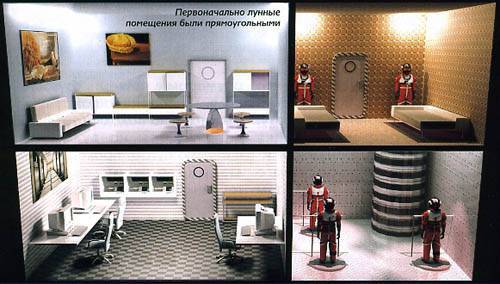
In various research institutes, various variants of future transformable structures were studied. For example, even self-hardening buildings. Considered and tape designs. In the transport state, they should have resembled a cylindrical metal sheath, only twisted and deflated into a roll. Directly on the spot, it had to be filled with air, puffing and keeping the shape in the future. Of greatest interest were the structures that would be built from biomaterials - materials with thermal "memory". The finished structures from such materials were planned to be flattened in a special way, actually turning into a cake, and sent to the Moon in this form. On site under the influence of high temperature, the design would take its original appearance. However, all these fantastic designs could not overcome even the stage of mock tests. As a result, Barmin chose precisely the ordinary cylindrical module-barrel.
The full-size prototype of the lunar module was built in the General Mechanical Engineering Design Bureau, and the layout of the future modules of the lunar base was tested. Various options were considered for a long time. But in the future, for unknown reasons, they decided to start up the model for scrap, and as a result only photographs of not the best quality came to us from it. The very first Soviet lunar base was supposed to consist of 9 separate modules (each with a length of 4,5 meters). All these modules had to be gradually delivered to the natural satellite of the Earth by means of transport ships.
The ready and assembled station from above was planned to be covered with a meter layer of lunar soil. According to its characteristics - it was the perfect heat insulator, as well as excellent protection from radiation. In time, an entire city should appear on the moon, which would have its own observatory, cinema, science center, gym, workshops, greenhouse, dining room, garages for lunar transport, a system for creating artificial gravity and even its own nuclear power plant. Especially for the lunar city, it was planned to create an 3 type of lunar transport — a heavy and light lunar rover and the multipurpose machine “Ant”. Its development was engaged in Leningrad VNIITransMash, which was known for the creation of armored products. Part of the created lunar vehicles had to work from solar energy, and some of the batteries. Machines that were designed to carry out long hikes, it was planned to equip the atomic small-sized reactors.
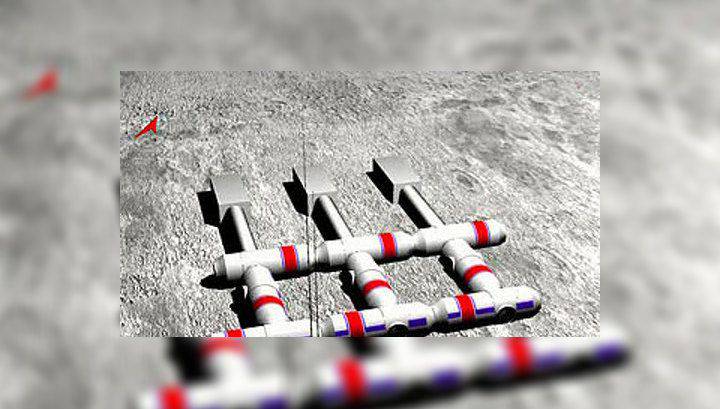
However, all plans to create a lunar base was never to be realized. Work on the design of the lunar city was in full swing, when 24 November 1972 of the year at 9 o'clock in the morning crashed the fourth lunar rocket H-1. Its three previous launches also ended in disaster. At that time, the Americans had already 3, walking freely on the moon. The leadership of the Soviet Union eventually decided to curtail the program H-1, which became the loudest failure of the Queen, and without a lunar launch vehicle, the project of the lunar base lost all meaning.
New stages of the lunar path
In the XXI century in Russia they again returned to the question of designing the lunar station. These works are just beginning, but it is already clear that the stages of research and exploration of the moon will differ little from what Vladimir Barmin offered. In any case, there will also be three stages of these.
The first stage, from 2016 to 2026 years, involves the study of the natural satellite of the Earth with the help of automatic devices. It is supposed to land in the areas of the South Pole of the Moon the automatic interplanetary stations Luna-25 and Luna-27. The study of the physical conditions in the polar region, as well as the regolith will have to do the station "Luna-26". And the delivery of lunar soil samples to our planet will be carried out by the Luna-28 station. As a result of these studies, scientists are going to find out the physicochemical properties and composition of the lunar polar regolith, as well as determine the most promising areas in the South Pole of the Moon for future deployment of the lunar test site and lunar base.
The second stage of the lunar program involves manned flights in the near-moon space, as well as the deployment of the necessary elements of the lunar space infrastructure. Including the creation of the Russian lunar polygon by the deep-space exploration program is planned later than 2030. Within two years, from 2030 to 2032 years, it is planned to start landing Russian cosmonauts on the moon, which could begin construction and construction of the base.
The third phase of exploration and exploration of the moon is scheduled for 2036-2050 years. There is no exact information on what exactly will happen at this stage. But it can be assumed that during this time the installation and adjustment should be completed on the moon, as well as the commissioning of all the necessary elements of the Russian lunar base.
At the same time, the Russian program of studying and researching the Moon acquires not only real features, but also cost. The project “Long-term deep space research program” was sent to the Russian government for approval, for which a record amount of 2050 trillion rubles could be spent before the 12,5 of the year. In this case, the numbers can still be revised. And private Russian companies also declare their interest in developing the lunar base. For example, the Russian company Lin Industrial (a resident of Skolkovo), announced its readiness to deploy a base on the Moon during 10 years after the decision had been taken.
Information sources:
http://tvzvezda.ru/news/forces/content/201501091737-jhw3.htm
http://tainy.net/11846-barmingrad.html
http://www.popmech.ru/technologies/6861-kosmos-novosti-7-13-sentyabrya-2007-g/#full
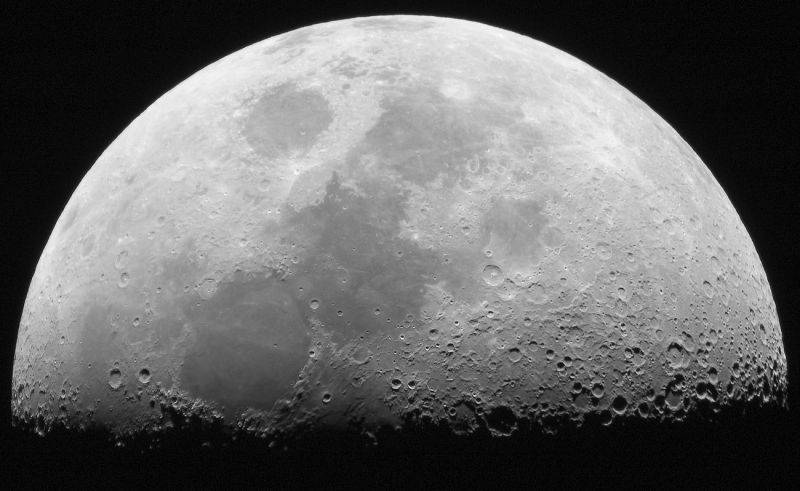
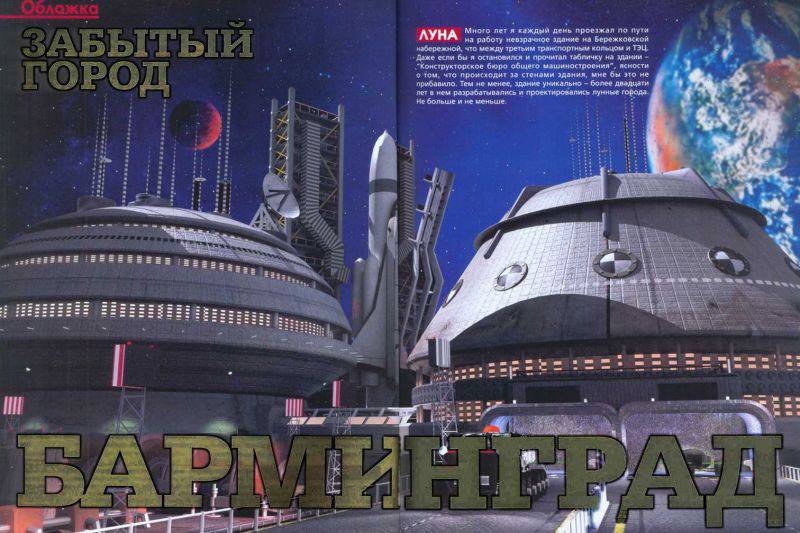
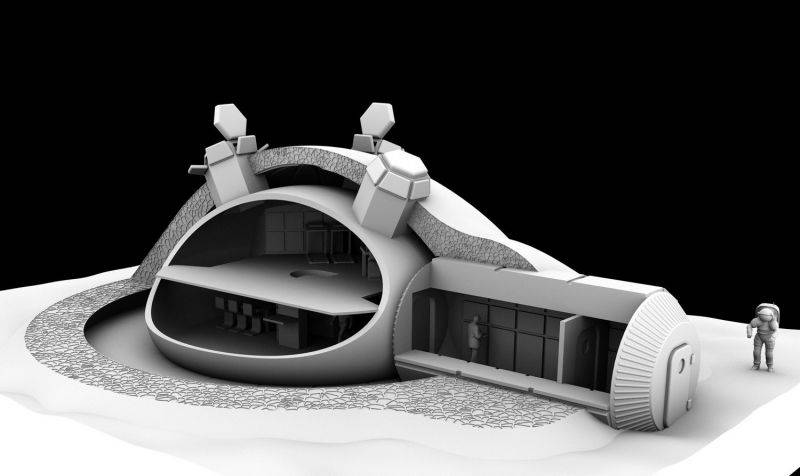
Information